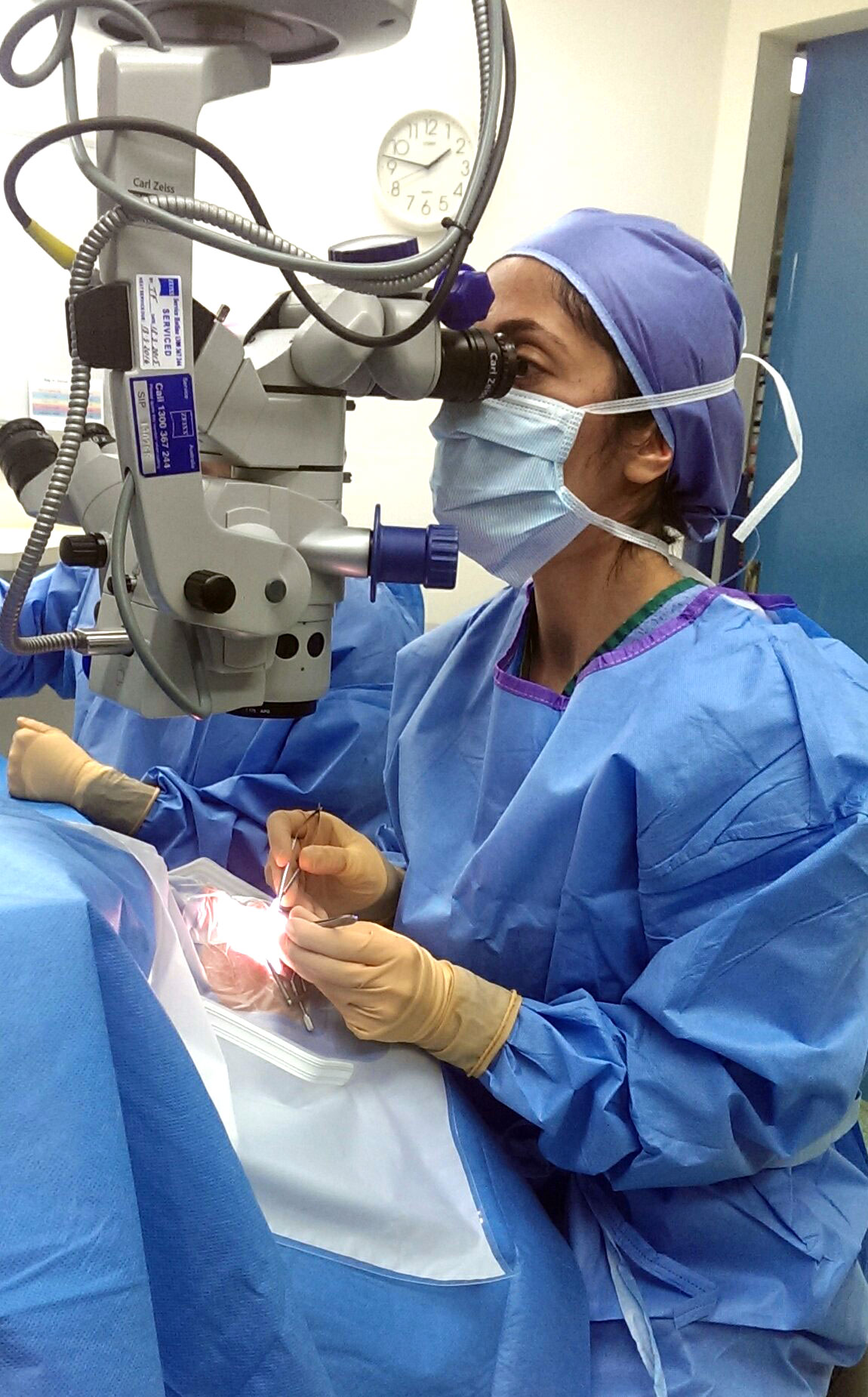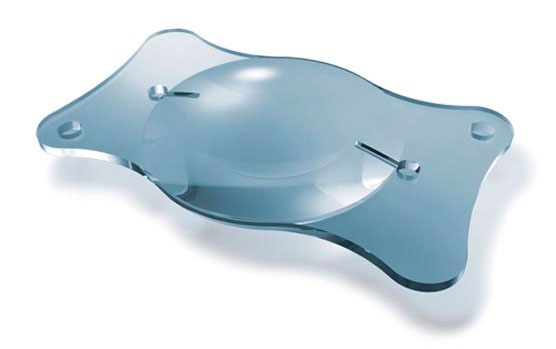Cataract surgery is the most commonly performed elective surgery in Australia, and permanently removes the cloudy lens protein that causes loss of vision with cataract. Once removed, an artificial lens implant is inserted into the eye to correct the patients’ vision.
What is a cataract?
A cataract is the clouding of the natural lens of the eye, limiting the amount of light that can enter, and preventing us from seeing well.
Cataract surgery is performed through a keyhole, microscopic and suture-less corneal incision. A highly sophisticated ultrasound probe is used to remove the cloudy lens, and an artificial transparent intraocular lens (IOL) is inserted in its place to restore better sight.
Cataract surgery is normally carried out as a day-case procedure. It typically only takes 15 minutes to perform, and is carried out under sedation and local anaesthesia, and is not painful.
Learn more about cataracts
On the day of your surgery
You will usually have your cataract surgery 1-4 weeks after the consultation with your surgeon. Most people spend between 2 and 2.5 hours at the day surgery, and we recommend that you take at least two days off work afterwards.
Many people bring a friend or family member with them to help them get home afterwards, as your vision may be blurry for 48-72 hours. It is a good idea to bring sunglasses to wear on the way home, and please don’t wear eye makeup on the day.
You will be able to see within a day of the procedure being completed, but it will be a few days before you can see well enough to drive.
At the day surgery, the nurse will use drops to dilate your pupil. They will discuss the aftercare with you, explaining the eye drops and how to look after your eyes immediately after treatment, and in the days that follow.
The anaesthetist will talk to you about the anaesthetic procedure. They will give you sedation and a local anaesthetic injection around the eye once you are sedated. Whilst cataract surgery is carried out under local anaesthesia for the vast majority of patients, a general anaesthetic may be used in particular circumstances. The surgery then takes approximately 15 minutes. After surgery, you will rest on the recovery ward for 30-45 minutes.

After your surgery
You will go home with a pad on the eye which you can remove 6 hours after getting home. Your eyes will feel tired and gritty for the rest of the day, so we advise you to stay at home and rest.
You will be able to see the next day, but your vision will be slightly misty for 48 – 72 hours. Depending on what your vision was like before, you may notice a dramatic improvement straight away.
Are there any risks with cataract surgery?
Cataract surgery is a safe and effective way to restore vision, and serious complications are very rare. Over 85% of our patients have better than 20/20 vision 1 month on from the procedure, and 95% of patients who otherwise have healthy eyes, have better than 20/40 vision (the legal driving standard) 1 month on from the procedure. Our surgeons have complication rates of around 0.15%, compared to the Australian average of 2% for cataract surgery, and are more than happy to disclose their results.
It is completely normal to experience a little blurred vision while your eyesight settles for a day or two, or in some cases for a week or two. Some people can require glasses for distance or near vision after cataract surgery. This and the various intraocular lens options will have been discussed with you during your initial consultation.
Months to years after cataract surgery, a minority of individuals do experience the onset of visual problems similar to those caused by cataracts, with symptoms including blurry vision and difficulty with glare from bright lights. This relatively common phenomenon is caused by a condition known as posterior capsule opacification and is caused by a thickening of the lens capsule that secures the artificial lens in place.
Treatment is a quick, simple, routine and very low-risk procedure called YAG laser capsulotomy and can be performed in rooms. Following this, patients can expect their sight to return to normal within a day or two (to the same level of sight that was originally restored by the cataract surgery).
Do you have another question about cataract surgery?
Click here to view our Cataract Surgery FAQs
Cataract surgery in complex cases
As surgeons who perform corneal transplants and reconstructive anterior segment surgery, we are often referred complex cases from other general eye surgeons, including cataract surgery in Fuchs’ dystrophy, radial keratotomy and combined corneal transplantations. Complex reconstructions of the front of the eye are also performed including implantation of artificial iris segments and pupil reconstructions.
If you suffer from cataracts, you are more than likely suitable for surgery. That being said, you should book an initial consultation with a specialist, where the appropriate treatment can be advised based on an assessment of your health and any other circumstances.
Premium intraocular lenses
Permanent lens replacement or cataract surgery has evolved from simple removal of a lens or cataract to restoration of best possible vision. With premium multifocal lenses this can mean distance and reading vision, and correction of astigmatism, with minimal need for glasses.
There are a number of lens options available. The best option for you dependents on a number of factors including your current prescription, personal preferences and lifestyle. Your surgeon can discuss these with you in more detail.

Cataract surgery lenses
Monofocal lenses
Corrects distance vision only, providing that the patient does not suffer from astigmatism. Glasses may still be required for reading or distance vision.
Premium intraocular lenses
Can correct astigmatism and/or offer both distance and reading vision simultaneously, allowing patients to be free from wearing glasses entirely.
Customised aspheric IOLs
Lenses can be specially tailored and customised to the individual optical properties of a patient’s eye to provide the optimal quality of vision.
Toric IOLs
Correct astigmatism as well as myopia and hyperopia. Multifocal and trifocal IOLs can also be used in toric format to address astigmatism whilst addressing near and distance vision.
Multifocal and trifocal IOLs
Are divided into multiple zones which are focused for distance, intermediate and near vision, allowing most patients to be free from wearing glasses entirely.
Extended depth of focus IOLs
Enable patients to have better vision across a broad range of distances from distance to intermediate. They are most suitable for active individuals, allowing the performance of a range of daily tasks without the need for spectacles.
IOL blended vision
The dominant eye is corrected for perfect distance vision and the non-dominant eye is corrected for reading/intermediate vision. The result is independence from glasses for all activities except close reading.
IC-8 pinhole IOL
The new lens is inserted into your non-dominant eye and uses a pinhole design that allows only focused light to enter the eye, giving patients greater independence from glasses for far, near and intermediate distances.
All surgical procedures carry some risk. The information provided here is for general educational purposes only. Please contact Forest Eye Surgery to find out what type of cataract surgery is appropriate for your individual situation.
For appointments and enquiries call (02) 9452 6444
Our rooms are open 8:30 am - 5:00 pm Monday to Friday
Unit 11, Building 7
49 Frenchs Forest Rd East
Frenchs Forest NSW 2086
info@foresteyesurgery.com.au
Phone: (02) 9452 6444
Fax: (02) 9452 6566
